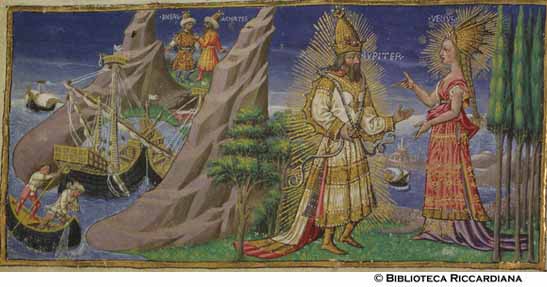Huck
Well, the chest and the same pictures as in the other Riccardiana-Resource (Virgil), less material but with a quicker view:
http://www.istitutodatini.it/biblio/images/it/riccard/492/htm/elenco.htm

both from Apollonio di Giovanni
nowhere they note, that it is a marriage chest
but the description says:
"The front panel of this cassone represents the conquest of Trebizond, on the Black Sea, by the Ottoman Turks under Sultan Mehmed II on August 14, 1461. This event resulted in the ouster of the Venetians from Constantinople and the gift of their property to the Florentines. The side panels of the cassone are decorated with the crest of the Florentine Strozzi family."
The war between the Osman and Venice started in 1463 and endured till 1479. As interesting detail it seems to be said, that Florence profited (got the properties of the Venetians; at least for a while) from this development, so had no oeconomical reasons to be enjoyed too much about the crusades idea of Pius II.
http://www.istitutodatini.it/biblio/images/it/riccard/492/htm/elenco.htm

both from Apollonio di Giovanni
nowhere they note, that it is a marriage chest
but the description says:
"The front panel of this cassone represents the conquest of Trebizond, on the Black Sea, by the Ottoman Turks under Sultan Mehmed II on August 14, 1461. This event resulted in the ouster of the Venetians from Constantinople and the gift of their property to the Florentines. The side panels of the cassone are decorated with the crest of the Florentine Strozzi family."
The war between the Osman and Venice started in 1463 and endured till 1479. As interesting detail it seems to be said, that Florence profited (got the properties of the Venetians; at least for a while) from this development, so had no oeconomical reasons to be enjoyed too much about the crusades idea of Pius II.

